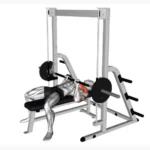Barbell Incline Bench Press Overview
The barbell incline bench press is a key strength-training exercise that targets the upper chest (pectoralis major), with secondary engagement of the shoulders (deltoids) and triceps. By using an incline bench, this variation emphasizes the upper portion of the chest, which is often underdeveloped in many lifters, while also enhancing shoulder stability and arm strength. Ideal for chest workouts, push sessions, upper-body routines, or full-body programs, the incline bench press is suitable for beginners and advanced lifters alike. It promotes muscle growth, improves pressing strength, and supports functional movements like pushing or lifting. Variations such as dumbbell incline presses or board presses can add variety or target specific ranges of motion. Incorporate this exercise to build a balanced, powerful upper body.
Barbell Incline Bench Press Instructions
- Set Up the Bench: Adjust an incline bench to a 30-45 degree angle and place it under a barbell rack. Ensure the bar is set just below shoulder height when lying down.
- Load the Barbell: Add an appropriate weight to the barbell, starting light if you’re new to the exercise to focus on form. Secure the weights with collars.
- Position Your Body: Lie back on the incline bench with your feet flat on the floor for stability. Retract your shoulder blades by pinching them together and pressing them into the bench to create a stable base.
- Grip the Bar: Grasp the barbell with an overhand grip, hands slightly wider than shoulder-width. Keep your wrists straight and thumbs wrapped around the bar for safety.
- Unrack the Bar: With a spotter’s help (if available), unrack the bar and hold it above your upper chest, arms fully extended. Engage your core and maintain shoulder retraction.
- Lower the Bar: Inhale and slowly lower the bar in a straight line toward your upper chest (near the base of your sternum). Keep elbows at a 45-degree angle to your body to reduce shoulder strain.
- Press Up: Exhale and press the bar upward by driving through your chest and extending your arms, stopping just short of locking your elbows. Push your body into the bench for added power.
- Repeat: Perform 3 sets of 8-12 reps, resting 60-90 seconds between sets. Maintain controlled movements throughout.
Barbell Incline Bench Press Tips
- Prioritize Form: Focus on technique before increasing weight to avoid injury. Ensure the bar travels in a straight line, aligned with your wrists and elbows.
- Shoulder Stability: Keep shoulder blades retracted throughout to create a solid foundation and protect your shoulders. Avoid letting them roll forward.
- Controlled Descent: Lower the bar slowly (2-3 seconds) to maximize chest engagement and prevent bouncing off your chest.
- Breathing Technique: Inhale as you lower the bar and exhale as you press up to maintain core stability and rhythm.
- Elbow Positioning: Keep elbows at a 45-degree angle to your torso, avoiding excessive flaring or tucking, to reduce shoulder stress.
- Grip Adjustments: Experiment with grip width based on arm length—longer arms may require a slightly wider grip. If you feel shoulder discomfort, widen your grip or try dumbbell variations.
- Leg Drive: Press your feet into the floor to engage your lower body, stabilizing your pelvis and boosting pressing power.
- Avoid Overarching: Maintain a slight arch in your upper back, but avoid excessive lower-back arching to prevent strain.
- Spotter Safety: Use a spotter for heavy lifts to assist with unracking and ensure safety during failure.
- Progress Gradually: Increase weight or reps over time, but prioritize form to maximize results and minimize risk.
Benefits: The barbell incline bench press builds a stronger, more defined upper chest, enhances shoulder and tricep strength, and improves pushing power. It also promotes better posture and supports functional upper-body movements.
Targeting your upper chest with incline presses? Dive into our Ultimate Guide to Muscle Groups for chest development.






